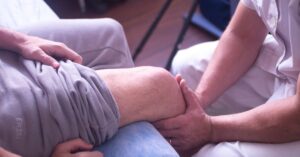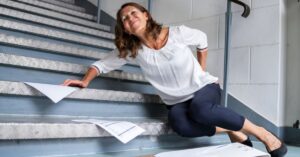Bouncing back from an injury can be a challenging and frustrating experience, but you’re not alone. Welcome to our latest blog post, where we’ll explore tried-and-tested techniques to minimize the risk of re-injury, ensuring a smooth and steady path towards peak performance. Whether you’re facing a sports injury first time or have experienced injuries in the past, let us be your guide on this empowering journey. So put any pre-conceived notions aside and let’s dive into the world of safe and effective recovery – designed exclusively for people like you who are determined to regain their strength and get back in action.
What is Re-Injury Risk?

Re-injury risk refers to the likelihood of an individual experiencing the same injury again after they have already suffered from it. This risk is particularly high for individuals who have previously experienced injuries that were not treated properly or who returned to physical activity too soon after an injury.
Benefits of Minimizing Your Re-Injury Risk
Minimizing your re-injury risk can have several benefits, including reducing the likelihood of future injuries, improving your overall physical performance, and increasing your overall quality of life. By taking steps to minimize your re-injury risk, you can ensure that you are able to continue participating in physical activities that you enjoy without having to worry about getting injured.
Physical Activity Guidelines for Minimizing Re-Injury Risk

To minimize your re-injury risk, it is important to follow certain physical activity guidelines. These guidelines include warming up before exercise, gradually increasing exercise intensity and frequency, varying your exercises to avoid overuse injuries, monitoring your body weight, and maintaining a healthy diet.
Warm Up Before Exercise
Warming up before exercise is essential for minimizing re-injury risk. A proper warm-up should include light aerobic exercise, stretching exercises for the muscles that will be used during the workout, and dynamic movements that mimic the exercises that will be performed during the workout.
Exercise Intensity and Frequency
Gradually increasing exercise intensity and frequency can help minimize re-injury risk by allowing your body time to adapt to new levels of physical activity. It is generally recommended that individuals increase their exercise intensity and frequency by no more than 10% per week.
Vary Your Exercises to Avoid Overuse Injuries

Overuse injuries are a common cause of re-injury risk. To avoid overuse injuries, it is important to vary your exercises and not perform the same exercises every day. This can help prevent muscle imbalances and reduce the risk of injury.
Monitor Your Body Weight
Monitoring your body weight is important for minimizing re-injury risk, particularly if you are overweight or obese. Carrying excess weight can put additional stress on your joints and increase the risk of injury. By maintaining a healthy body weight, you can reduce your risk of injury and improve your overall physical performance.
Maintain a Healthy Diet
Maintaining a healthy diet is also important for minimizing re-injury risk. A diet that is rich in nutrients, such as fruits, vegetables, lean proteins, and whole grains, can help support muscle growth and repair, reduce inflammation, and improve overall physical health.
Common Types of Injuries That Can Lead to Re-Injury Risk

There are several types of injuries that can lead to re-injury risk, including knee pains and strains, abdominal muscle tears or partial tears, calf muscle strains, and more. It is important to seek proper medical treatment for these injuries and follow a rehabilitation program to minimize the risk of re-injury.
Knee Pains and Strains
Knee pains and strains are common injuries that can lead to re-injury risk. These injuries can be caused by overuse, improper form during exercise, or trauma to the knee joint. To minimize the risk of re-injury, it is important to rest the knee joint, perform strengthening exercises for the muscles surrounding the knee joint, and gradually return to physical activity under the guidance of a medical professional.
Abdominal Muscle Tears or Partial Tears
Abdominal muscle tears or partial tears are another common injury that can lead to re-injury risk. These injuries are often caused by sudden movements or overuse of the abdominal muscles. To minimize the risk of re-injury, it is important to rest the affected area, perform strengthening exercises for the abdominal muscles, and gradually return to physical activity under the guidance of a medical professional.
Calf Muscle Strain or Tear
Calf muscle strains are also a common injury that can lead to re-injury risk. These injuries are often caused by overuse or sudden movements of the calf muscles. To minimize the risk of re-injury, it is important to rest the affected area, perform stretching and strengthening exercises for the calf muscles, and gradually return to physical activity under the guidance of a medical professional.
Core Muscles and Plyometric Exercises to Strengthen Your Body Against Re-Injury Risk

Core muscles and plyometric exercises are great ways to strengthen your body against re-injury risk. Core muscles, such as the abdominals, lower back, and hips, help support the spine and improve overall physical performance. Plyometric exercises, which involve explosive movements like jumping and hopping, can help improve muscle power and reduce the risk of injury. Examples of core exercises include planks, bridges, and Russian twists, while examples of plyometric exercises include box jumps, jump squats, and lateral bounds.
Building a Recovery Plan After an Injury Occurs
Building a recovery plan after an injury occurs is essential for minimizing re-injury risk. The first step in building a recovery plan is to seek proper medical treatment for the injury. This may involve rest, physical therapy, or surgery depending on the severity of the injury. Once the injury has healed, it is important to gradually return to physical activity under the guidance of a medical professional. This may involve performing specific exercises to strengthen the affected area or modifying your physical activity to reduce stress on the injured area. By following a recovery plan and taking steps to minimize re-injury risk, you can ensure that you’re able to continue participating in physical activities that you enjoy without having to worry about getting injured again.
Seek Professional Advice from our team at Alberta Back and Neck Rehab Clinic in Calgary
If you’re looking for professional advice on how to minimize your re-injury risk or build a recovery plan after an injury occurs, our team at Alberta Back and Neck Rehab Clinic in Calgary is here to help! Our experienced medical professionals can provide you with personalized advice and guidance on how to safely and effectively return to physical activity after an injury. We offer a range of services, including physical therapy, chiropractic care, massage therapy, and more. Don’t hesitate to contact us for help – we’re here to support you on your journey towards better health and wellness!




